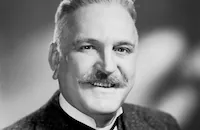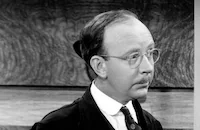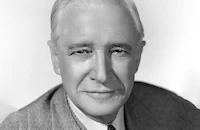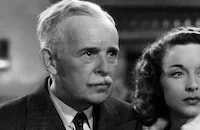A Lost Lady

Brief Synopsis
Cast & Crew
Alfred E. Green
Barbara Stanwyck
Frank Morgan
Ricardo Cortez
Lyle Talbot
Phillip Reed
Film Details
Technical Specs

Synopsis
Just before her marriage, Marian Ormsby learns that her fiancé, Ned Montgomery, has been killed by the husband of the woman with whom he has been having an affair. Her uncle sends her to the mountains to recover from her tragedy, and there she meets Daniel Forrester, an older corporation lawyer from Chicago, who saves her from a fall. Daniel falls in love with her and proposes. Believing that she can never love again, Marian agrees to marry him on the condition that honesty rather than love will be the basis of their marriage. They are happy until Frank Ellinger, a pilot, makes a forced landing in their garden, and Marian falls in love with him. She tells Daniel about their affair, and although he is stunned, he hides his hurt until he is brought home one day with a heart attack. Marian guiltily sends Frank away and nurses Daniel through his illness. Daniel is cold to Marian during his recovery. When Marian reads a newspaper announcment of Frank's approaching marriage, she telephones him to beg him not to marry, but cancels the call before he answers. When Daniel is nearly well, he asks Marian to stay near him and absolves her from blame for her affair with Frank. Marian and Daniel kiss and admit their love for one another.

Director
Alfred E. Green
Cast

Barbara Stanwyck

Frank Morgan

Ricardo Cortez

Lyle Talbot

Phillip Reed

Hobart Cavanaugh

Rafaela Ottiano

Henry Kolker
Willie Fung
Walter Walter

Samuel Hinds

Edward Mcwade
Jameson Thomas
Colin Kenny
Eddie Shubert
Harry Seymour
Lorena Layson
Edward Le Saint

Howard Hickman

Addison Richards
Lee Beggs

Joseph Crehan
Tom Parson
Sam Godfrey
Eulalie Jensen
John Elliott

Edward Keane
Crew
Wesley Anderson
Paul Burnett
John Ellis
Sid Hickox
Vernon Larson
Gene Markey
Owen Marks
L. P. "dudie" Mashmeyer
Jack Okey
Pat Patterson
Kathryn Scola
James Seymour
Frank Shaw

Film Details
Technical Specs

Articles
A Lost Lady
A Lost Lady (1934) centers on Marian's difficult recovery from depression following her fiancé's death with the help of an older, wealthy lawyer Daniel Forrester (Frank Morgan). After rescuing Marian from a terrible fall at a mountain retreat, Daniel becomes enamored with the heartbroken woman. He proposes marriage, and while Marian agrees she tells him she will never love again.
The couple's whirlwind life of polo, tennis and a magnificent new mansion built for Marian ends when she discovers she is still capable of falling in love. The object of her affection is handsome young pilot and businessman Ellinger (Ricardo Cortez) who threatens the security and happiness Marian and Daniel have built together.
Barbara Stanwyck was the second leading lady - following Irene Rich in the 1925 silent version - to star in a screen adaptation of Willa Cather's Pulitzer Prize-winning novel A Lost Lady. But Cather did not like the cinema and was disappointed by both screen adaptations of her novel. After viewing the Stanwyck version she wrote a stipulation into her will forbidding any more movie adaptations of her work.
Originally published as a three-part serial in Century magazine, A Lost Lady was in the tradition of nineteenth century novels of adultery like Madame Bovary and Anna Karenina, and told the story of the love affair and eventual financial downfall of the young wife of a Nebraska banker. The novel was an admitted influence on F. Scott Fitzgerald who read it while writing The Great Gatsby.
The character of Marian Ormsby was based on the wife of the governor of Nebraska, Mrs. Silas Garber. Garber's death in 1921 inspired Cather to begin the novel based on her recollections of the lively, beautiful California-born Garber of whom Cather remembered in James Woodress's biography Willa Cather: A Literary Life, "I wasn't interested in her character when I was little, but in her lovely hair and her laugh which made me happy clear down to my toes." Cather (O Pioneers!, My Antonia), who moved from Virginia to Nebraska as a child, took Nebraska as the setting for a number of her novels.
Frank Morgan, who played Marian's older husband, was only 44 when A Lost Lady was filmed, but made to look far older to be believably doddering next to the lovely Stanwyck who was singled out for praise in what was generally viewed as a mediocre film.
Stanwyck was widely seen as more talented than the lackluster adaptation of Cather's novel to the screen demanded. Despite sharing the same writers Gene Markey and Kathryn Scola and the same director Alfred E. Green, A Lost Lady had none of the salty punch of Stanwyck's pre-Code gold digger yarn Baby Face (1933).
In reviewing A Lost Lady the New York Sun enjoyed the performance despite lamenting the film, "Barbara Stanwyck, as usual, almost saves the day by giving one of her earnestly honest performances." The New York Mirror struck a similar note, observing, "Miss Stanwyck is so plausible, so sincere and so convincing that any story she plays becomes interesting. She carries A Lost Lady quite alone and makes it fairly interesting."
Stanwyck made over eighty movies during her career in Hollywood. Raised in a series of foster homes, the orphan born Ruby Stevens overcame that sad childhood to become one of the most iconoclastic and successful actresses in Studio-era Hollywood.
Entering show business as a chorus girl, Stanwyck found her first big break in Frank Capra's Ladies of Leisure (1930). She signed on with both Columbia and Warner Bros. and became known for her ability to handle all genres, performing as well in screwball comedies such as The Lady Eve (1941) as in heart wrenching melodramas (Stella Dallas, 1937) and film noirs (Billy Wilder's Double Indemnity, 1944). One of the few actresses able to survive and prosper with a transition to television, Stanwyck found reincarnation as a Western matriarch in the television drama "The Big Valley" from 1965-1969, winning three Emmys over the course of her career in television.
Yet, despite a career defined by shape-shifting performances in work by some of the luminaries of the Studio-era such as Preston Sturges, Frank Capra, King Vidor, John Ford and Howard Hawks, Stanwyck never won an Oscar®. In 1982, however, she did receive an honorary Academy Award for her work.
Director: Alfred E. Green
Screenplay: Gene Markey and Kathryn Scola based on the novel by Willa Cather
Cinematography: Sid Hickox
Production Design: Jack Okey
Music: Leo F. Forbstein
Cast: Barbara Stanwyck (Marian Ormsby), Frank Morgan (Daniel Forrester), Ricardo Cortez (Ellinger), Lyle Talbot (Neil), Phillip Reed (Ned Montgomery), Hobart Cavanaugh (Robert), Rafaela Ottiano (Rosa).
BW-61m.
by Felicia Feaster

A Lost Lady
Quotes
Trivia
Notes
According to a June 1934 Hollywood Reporter news item, John Eldredge was cast in the film, but left the production when he was cast in First National's Flirtation Walk. A March 1934 Hollywood Reporter news item announced Kay Francis would star in the film. The first reel was missing from the viewed print. Cather's story was first filmed by Warner Bros. in 1925. It starred Irene Rich and was directed by Harry Beaumont (see AFI Catalog of Feature Films, 1921-30; F2.3196).















